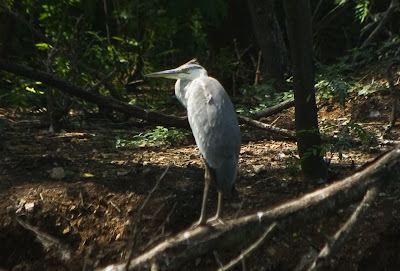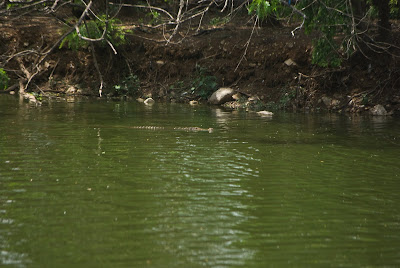- Its the lowest point on dry earth
- Its salty, very salty
- There's no life in it
My son did not seem very impressed with these points, as a reason to visit. I argued with him, we're never going to stand on the highest point, so lets atleast go to the lowest point!
OK, we did not go all the way from Madras just to check out this geographical phenomenon, but happened to be in the neighbourhood.
6th June 2009. Amman, Jordan
10 am, and we set off for the 45 min drive to the northern tip of the Dead Sea. My son did not think this was a good idea, especially since I packed swim trunks - What? You're going in to the Dead Sea?, he enquired querulously. His mood improved significantly on seeing our mode of transport - a Mercedes (dont ask me which one), with our friendly driver cum guide, Fadi.
All through the journey, Fadi chattered on incessantly, about Jordan, the Dead Sea, the benevolent dead king, the dynamic current king, etc etc. The roads were good, his driving even-handed and the sun outside sharp. I feared that I would drop off to sleep with the drone of his voice and the gentle motion of the car, and so made sure that I asked questions every now and then!
So I learned about the therapeutic effects of the Dead Sea, the lousy neighbours that Jordan has to suffer (I didn't tell him that we had the same problem), the political problems of sharing the river Jordan and even some biblical history about Moses!
Suddenly, he brought the car to a halt, behind a huge tourist bus, and as I wondered why, I saw this board, on the roadside!
 We were at sea level! Needing to descend another 300 m to reach the shores of the Dead Sea. See those red spots, thats where we were. The altitude of Madras, and where we would find the Mediterannean Sea as well.
We were at sea level! Needing to descend another 300 m to reach the shores of the Dead Sea. See those red spots, thats where we were. The altitude of Madras, and where we would find the Mediterannean Sea as well.It reminded me of another board a long time ago. 4,000m, Rohtang Pass!
So, we stood besides the board and had our pictures taken dutifully, as our driver took several quick puffs on his cigarette - I suspect that's the reason they stop at this board. So they get their puffs and we get our photos!
 Here's the other marker in the sand, to convince us that we were at sea level! The terrain around is rolling hills, with olive groves in some of the valleys but generally bare.
Here's the other marker in the sand, to convince us that we were at sea level! The terrain around is rolling hills, with olive groves in some of the valleys but generally bare.We could see the road drop down, and the driver pointed out a blue speck in the distance as the Dead Sea.
But doesn't the river Jordan flow into it? The river is dry, declared our driver flatly. Dammed by Israel, Jordan and Syria, so there's no water from the river into the Dead Sea. At this rate, soon there will be no Dead Sea. Already, the southern end has become mud flats, since the Dead Sea is really a lake, a very large one, and so needs the water to flow in.
We soon reach the bottom of the Dead Sea valley, the Jordan rift valley. Uh oh, should I be nervous? Isn't a rift valley not a very safe place to be? Arabia moved away from Africa many million years ago, and we have this huge "crack" in the earth's floor? I think thats a simple enough explanation for me.
The road is now flat and straight like an arrow. we reach a T-junction and turn left. The driver points out to me that this is not a T-junction but a four way crossroad - the fourth direction westwards, being the road to Jerusalem through the West Bank, and so blocked off and unused.
Now we were on the east bank of the Dead Sea, but it was hidden from view. Suddenly there was a check-post ahead, and cars were being stopped and papers checked. I did not have a jot of identification on me, having left everything behind at Amman. Hmmm, lets see how this pans out, I thought. But, Fadi was probably well known in the area and friendly phrases were exchanged, and all I could make out was "indo"...I guess he was telling the policeman we were from India, and we were waved through.
So, we arrived at the Dead Sea Spa Hotel. The oldest hotel on the block. How it works is like this. There is a "public beach", but we were advised against going there - its dirty, was the reason - and we were told to take a day pass into one of the private-hotel owned beaches, which is what we did. So, the package typically involves giving you towels, providing showers and a changing area, and there's a lunch thrown in.
We walked through the hotel, and on to the "sea front", to see this.
 We came all the way to see this drab and still "pond" and these barren shores???, my head screamed out, but I maintained a non-commital face (Cant show the son how I feel can I?). Where are those dramatic cliffs and salt-encrusted rocks that I have seen in pictures? I must say, that I did feel let down at this moment. (Turns out, that the spectacular scenery is on the Israeli side. Oh well.)
We came all the way to see this drab and still "pond" and these barren shores???, my head screamed out, but I maintained a non-commital face (Cant show the son how I feel can I?). Where are those dramatic cliffs and salt-encrusted rocks that I have seen in pictures? I must say, that I did feel let down at this moment. (Turns out, that the spectacular scenery is on the Israeli side. Oh well.)I looked around and to my chagrin, the changing rooms were located behind this picture, if you know what I mean. So, we had to trek down the entire distance in our swim suits!! I began to chicken out, and then looked around and saw all the visitors quite happily roaming around in the briefest of swimwear, with nobody giving them a second look, and I said, oh what the hell, come on nobody knows us here, lets go!
 My son had this, oh-no, what-have-I-got myself-into, look, and so I had to lead from the front so-to-speak!
My son had this, oh-no, what-have-I-got myself-into, look, and so I had to lead from the front so-to-speak!But reading this board, he perked up. Oh, so I dont have to swim, swim, and I dont have to put my head in the water. I just have to float and do nothing. Not so bad!
So it was, that we entered the waters of the Dead Sea, tentatively at first, but then with more gusto and verve. After a while we were enjoying ourselves! Its a bizarre sensation, especially if you are used to swimming in a pool or fresh water. The salt and mineral content push you up, and you can "walk" effortlessly in the water.
 This is the view from the water, looking up at the Jordanian shore. Not very interesting is it? And there are hotel projects still coming up...
This is the view from the water, looking up at the Jordanian shore. Not very interesting is it? And there are hotel projects still coming up...In case you are wondering about those people who look like they are wearing a scuba-diving outfit, they are visitors covered in the Dead Sea mud! I did it too, much to my son's disgust, but in order to prevent this blog from being rated as "horror" or grotesque", I shall refrain from posting visual proof!
 Soon, it was time to leave, and here's a final look at the cliffs of Palestine...there was not a soul on the other side of the Dead Sea...I wonder if its a restricted area...
Soon, it was time to leave, and here's a final look at the cliffs of Palestine...there was not a soul on the other side of the Dead Sea...I wonder if its a restricted area...We showered away the oily waters of the Dead Sea, and attacked the buffet lunch with our healthy appetites!
Fadi was quieter on the return, though he did the usual touristy thing of taking us to a souvenir shop, where I bargained down the price of a Bedouin rug pretty dramatically, bought some Dead Sea mud and posed for a picture with the traditional Arab headgear!
It was an interesting day out. But since we were not into spa experiences or therapeutic swims, I wonder if it would have been better if we had gone off to the Mujib Nature Reserve, further south along the Dead Sea? Again, our Amman hotel concierge discouraged us from this. It was not a good season for such a trip I think.

 A juvenile Brahminy Kite?
A juvenile Brahminy Kite? Click on the picture, you can see the storks circling in the sky above
Click on the picture, you can see the storks circling in the sky above

 See the red loral spot of the spot-billed duck
See the red loral spot of the spot-billed duck
 The grey heron "grins" triumphantly with breakfast in its mouth, while a pond heron looks the other way, unimpressed by its catch!
The grey heron "grins" triumphantly with breakfast in its mouth, while a pond heron looks the other way, unimpressed by its catch! This egret waits patiently, framed against the grass
This egret waits patiently, framed against the grass
 A brahminy kite looks across the lake
A brahminy kite looks across the lake Painted stork
Painted stork Oriental Magpie Robin
Oriental Magpie Robin Asian koel - female
Asian koel - female Asian koel-male
Asian koel-male Grey heron
Grey heron Coucal
Coucal
 Star Clusters
Star Clusters  Yellow alders
Yellow alders A butterfly and a shoe!
A butterfly and a shoe! Striped Tiger?
Striped Tiger? Glassy Tiger
Glassy Tiger


 A crocodile glides by in the water
A crocodile glides by in the water



 Bauhinia
Bauhinia Bougainvillaeas
Bougainvillaeas  Bougainvillaeas
Bougainvillaeas  Bougainvillaeas
Bougainvillaeas  Bougainvillaeas
Bougainvillaeas  Adenum
Adenum Ixora
Ixora Cassia fistula (amaltas)
Cassia fistula (amaltas) Peltophorum pterocarpum
Peltophorum pterocarpum Tabebuia
Tabebuia 
 Catharanthus roseus
Catharanthus roseus  Spathodea campanulata
Spathodea campanulata Quisqualis indica
Quisqualis indica